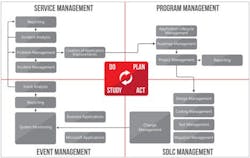The industrial technology sector is one fraught with overused terms. From connected networks and Big Data to the Internet of Things and software architectures, we have no shortage of terms that are used correctly, incorrectly and—most often—somewhere in between. Another term that receives a good deal of overuse is IT/OT convergence—i.e., the covergence of front office/corporate information technology (IT) with operations technology (OT) functioning on the plant floor .
IT/OT convergence is a real issue for industrial companies in light of the growing wave of digital technologies proliferating on the plant floor, but it is often misunderstood in terms of what it means and how it should be applied. From the industrial side, we often hear about how IT doesn’t understand plant floor technologies or metrics, or what real time means to automation devices on production equipment. At the same time, the industrial side doesn't always hear key insights that the IT side may offer, such as the risks of using unsupported technologies, or where systems interact and what certain points of failure may exist in those intersections, or how to apply infrastructure library best practices.
“IT/OT convergence is not an academic exercise,” says John Southcott, co-CEO of Brock Solutions, an engineering and professional services company specializing in the design, build and implementation of real-time solutions for global industrial and manufacturing and transportation/logistics organizations. “The bottom line is IT/OT are converging whether we like it or not. OT can no longer isolate itself in order to get the job done. And IT can’t force standards and procedures that simply don’t work in an OT environment.”
Before joining Brock Solutions in 2006, Southcott was a partner at Deloitte Consulting focused on the IT space.So, shortly after joining Brock Solutions, he was shocked to see a steel plant still using DEC PDP-8s, Data General Nova minicomputers in a warehouse/distribution facility, and IBM System/36s in a consumer products company. These systems were all being used in 2006 to run mission critical operations. “From an IT perspective, these systems were obsolete when I was a student," he says. "And believe me that was a very long time ago.”
Having viewed Southcott’s LinkedIn page, I noticed he joined Deloitte in 1980, so he’s being very honest about the age of these systems.
Today, Southcott says he sees widespread interest in technologies such as analytics, cybersecurity, artificial intelligence, machine learning and augmented reality as being areas where no IT/OT boundaries exist. “In fact, these technologies—when deployed effectively—impact the entire enterprise, which ultimately means convergence.”
With insights from his early career IT experience, mixed with his later career OT expertise, Southcott says the key to getting IT and OT on the same page to move business forward requires two foundational elements—addressing the basics and building trust, respect and credibility.
Some of the basic issues that IT can help OT address, include:
* Staying Current. “Many organizations consciously choose to remain on unsupported technology and accept the associated risks for their OT systems,” Southcott says. “The ‘If it isn’t broken, don’t fix it’ approach—which may have worked in the past—may now represent an unacceptable risk. A client of ours recently experienced a multi-day outage when a system running on unsupported technology failed, which resulted in significant cost and customer service issues.”
* Ill-Defined Resiliency. Many OT environments don’t understand where their systems intersect and where potential points of failure exist.
* Security. “When it comes to OT security, a client once told me that whenever he hears ‘secure the perimeter’ as the solution he stops listening,” says Southcott. “But the reality is that just about every machine deployed on the plant floor has technology that represents a potential security threat and shutting off access is simply not practical. Cybersecurity is an enterprise challenge, not a functional challenge.”
One of the best practical examples of IT/OT convergence Southcott likes to reference involves applying Information Technology Infrastructure Library (ITIL) best practices to the OT environment. “ITIL is a set of detailed practices for IT service management, and many IT departments of large organizations are ITIL certified,” he says. “However, what we have discovered is OT is often not within the traditional ITIL scope. So, in partnership with one of our clients, we applied ITIL best practices to OT and the results have been excellent. Metrics and procedures were developed that work for OT and we have seen dramatic improvements in incident management and continuous improvement initiatives.” (see OT Sustainment Model image)
Southcott notes the manufacturers that work with Brock Solutions who have embraced IT/OT convergence are “getting things done quickly and, at the end of the day, have the results to show for it.” He points out that it’s important to realize that IT/OT convergence is “not overly complicated or about having ice cream socials and hugs. Actually, it’s about moving past terms like IT/OT convergence or choosing sides and looking for practical initiatives that benefit the enterprise in terms of efficiency and growth opportunities.”
About the Author
David Greenfield, editor in chief
Editor in Chief

Leaders relevant to this article:
